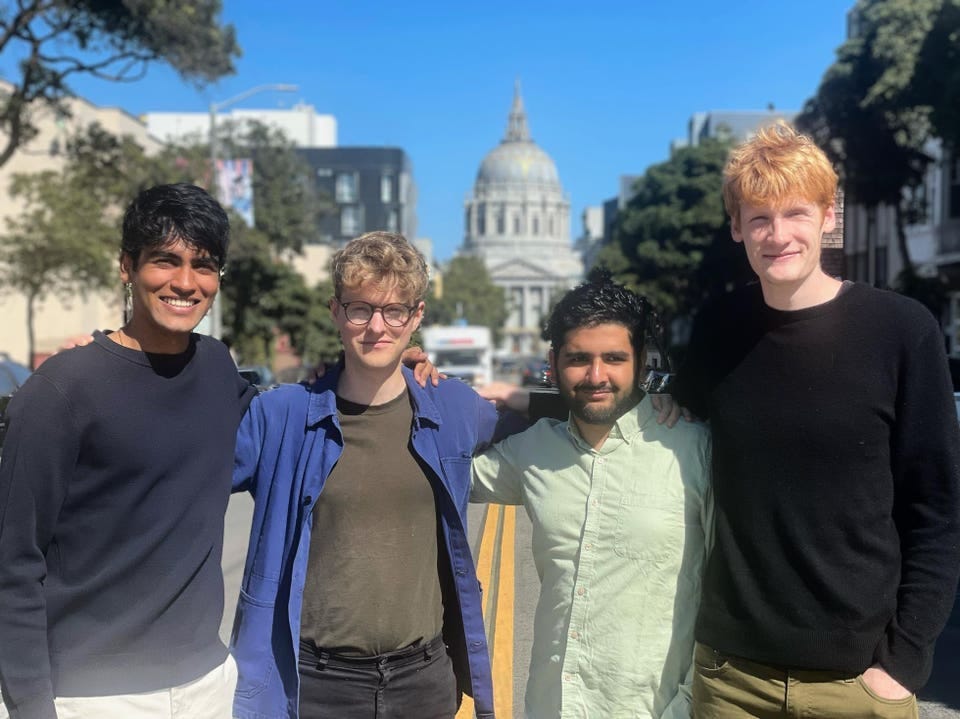What does Cursor do?
How four class of 2022 MIT grads built the leading AI code editor and are redefining what's possible in software development
Cursor, developed by Anysphere, has emerged as the breakout success story in the AI-powered development tools space. Scaling to $50M in ARR in just 18 months seeing insatiable investor interest, Cursor exemplifies the gamechanging potential of AI in working with code and the productivity gains of AI-native development environments. The company's meteoric rise, marked by a valuation surge from $400 million to $2.5 billion in just four months, signals a paradigm shift in how developers interact with their tools.
Founding Team
The MIT graduates behind Cursor launched with a simple yet audacious vision: to fundamentally reinvent how the world's software is written. The founders saw programming was about to change significantly and set out to create what they called a "truly magical tool" – an editor where developers could generate 2,000-line pull requests from just 50 lines of pseudo code, eliminate bugs entirely, and get instant answers to any codebase question. Their mission wasn't just about building a better code editor, but about redefining what it means to program. The ultimate vision is to enable developers worldwide to focus on bigger problems while the mundane aspects of coding "melt away."
Recommended Podcast: Lex Fridman’s “The Future of Programming” podcast
Founded in 2022 by MIT students, all of which are class of 2022 grads and started Anysphere right out of university:
Michael Truell: Interned at Google, Two Sigma and Octant and was a USA Computing Olympiad Finalist
Sualeh Asif: Interned at IBM and was a lab/research assistant at MIT
Arvid Lunnemark: Worked at Stripe and Jane Street in engineering and quant
Aman Sanger: Worked at You.com and Bridgewater in engineering and investments
Unclear how many employees Anywhere has, as it still has no LinkedIn page. The team is based in San Francisco.
Growth and Market Traction
Revenue scaled from $4 million ARR in April 2024 to $50 million ARR as of November 2024 per TechCrunch
Grown to over 40,000+ customers across startups, AI research labs, and enterprise
The fastest independent adoption of an AI-first developer tool, with other top vendors including Augment, Codeium, Magic, and Poolside
Core Product Differentiators
Technical Innovation
Deep integration with entire codebases for contextual understanding
Ability to match and suggest code in developer's personal coding style
Advanced file relationship comprehension within projects
Multi-vendor LLM support, including both OpenAI and Anthropic models
Developer Experience
Contextual Code Generation with project-wide understanding
Natural Language Code Editing capabilities
Intelligent Code Analysis and real-time suggestions
Seamless integration with existing development workflows
Built on familiar VSCode architecture
The Future of Programming and Developer Productivity
Recent field experiments and research papers have provided the first rigorous empirical evidence of AI's impact on software development, with GitHub Copilot and GPT-3.5 setting initial productivity benchmarks:
26% increase in overall developer efficiency
38% increase in code completion rates
Strongest gains seen among entry-level engineers
Results achieved using older GPT-3.5 technology
Industry analysts expect Cursor to dramatically exceed these benchmarks due to its next-generation architecture and sophisticated feature set:
Built on newer, more capable language models
Deeper IDE integration compared to plugin-based approaches
Comprehensive understanding of entire codebases for better context
Adaptive learning of individual developer coding styles
Multi-model support leveraging both OpenAI and Anthropic
Expected to significantly outperform current productivity benchmarks
Product Roadmap
Cursor shared its “Problems for 2024-2025”, which detail its roadmap and key features it’s looking to add:
Next Action Prediction: Develop models to predict user actions for smoother code navigation and tool usage. Surface relevant code snippets or documentation based on user actions.
Perfect Edits: Scale computation to allow more complex and higher-quality code edits. Enable background processing for edits without interrupting the coding workflow.
Optimal Context: Implement advanced retrieval and long-context processing for large documentation and codebases. Enhance memory handling with transformer-based search for accurate context access.
Bug Detection and Debugging: Expand the cursor/debug library to track detailed program states. Create background agents for passive bug detection across codebases.
This roadmap provides a high-level plan to improve Cursor’s intelligence, context handling, and bug detection capabilities for developers.
Strategic Advantages
First-mover benefits in AI-native development, seemingly the preferred interface for most AI-first developers
Strong technical moat through codebase understanding and AI research
Multi-LLM strategy reducing vendor dependency
Rapid feature iteration and deployment
Potential risks
Competition from OpenAI's and Github Copilot direct features
Continued AI research investment to maintain market position, as well as support for multiple languages
Well funded startups including Augment, Codeium, Magic, and Poolside
Investment and Valuation Trajectory
Recent valuation offers reaching $2.5 billion from top VCs per TechCrunch [link], up from $400 million valuation in July 2024
$60 million Series A in August 24 led by a16z and Thrive [announcement]
Notable early investors include OpenAI Startup Fund who led the $8M seed with Patrick Collison (Stripe co-founder), Nat Friedman (former GitHub CEO), and Arash Ferdowsi (Dropbox co-founder)
Conclusion
Cursor has emerged as a category leader in AI-first developer tooling, with growth metrics that astound even by AI startup standards. The company's explosive trajectory – scaling from $4 million to $50 million ARR in just 7 months while catapulting from a $56 million seed valuation to $2.5 billion in 16 months – is credence to its product-market fit and developer love. As traditional IDEs increasingly look antiquated without AI and with most engineers already integrating AI coding assistants into their workflows, Cursor stands uniquely positioned at the intersection of two massive tailwinds: the exponential growth in both software development and in AI adoption.









“Strong technical moat through codebase understanding and AI research”
Color me skeptical: does this codebase understanding belong (exclusively) to the company? Is it hard for others (eg Microsoft or Google or GitHub) to reproduce? If so how and why? Is this company actually doing significant research? How do they find time to manage that with such growth rates, and why would that research be hard for big competitors to replicate?